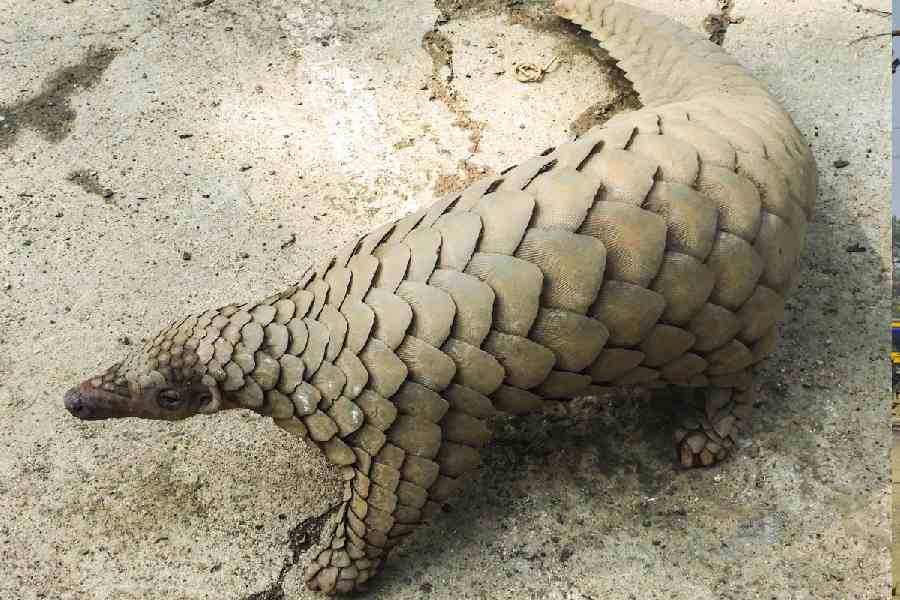Cameras in the forests of Purulia have in the past six months captured multiple images of pangolins, a shy and protected anteater that is among the world’s most trafficked animals.
Bengal’s forest department and the Human and Environment Alliance League (Heal), an NGO, installed the cameras to assess the distribution of Indian pangolins in Purulia so that conservation measures can be put in place.
“This is the first such study of pangolins in south Bengal. The pangolin is such a secretive animal that finding its abode and studying its behaviour takes a lot of time,” Debal Ray, head of Bengal’s Forest Force, said.
“We are lucky to have found pictures in six months. This is the first step towards the conservation of one of the most heavily traded animals.”
These scaly mammals are toothless and nocturnal. They live in burrows and feed mainly on ants and termites. Threatened, a pangolin rolls up into a ball.
“The scales and meat of (illegally killed) pangolins are mostly smuggled into China, followed by places in Southeast Asia. Nepal and Bhutan are favoured routes because of their proximity to China,” a forest official said.
“Bengal shares borders with Nepal and Bhutan and, naturally, is a busy transit point. Even locally, pangolin meat is widely consumed.”

A pangolin caught on forest cameras in Purulia.
China, followed by Vietnam, is the biggest consumer of pangolin scales and meat, sources in the Wildlife Crime Control Bureau said. Pangolin meat is considered “tonic food” because of its “medicinal properties” and the scales are used in traditional Chinese medicines.
An analysis by Traffic and WWF-India — NGOs working for conservation — of pangolin seizures in India in 2018-22 has found that 1,203 pangolins were trafficked after 342 seizures.
“Over 880kg of pangolin derivatives and 199 live pangolins were reported in the seizure incidents in the five years,” a report by Traffic said.
At least five people have been arrested in Purulia since 2021 for alleged possession of pangolin scales, sources said.
India is home to two pangolin species — the Indian pangolin (Manis crassicaudata) and the Chinese pangolin (Manis pentadactyla). Hunting and trade in either species is banned under the Wildlife (Protection) Act, 1972.
The Indian pangolin is cited as “endangered” and the Chinese pangolin as “critically endangered” on the International Union for Conservation of Nature Red List of Threatened Species.
Indian pangolins are around two to four feet long and weigh between 9 and 18 kilos. Chinese pangolins are marginally smaller and lighter.
Indian pangolins are found to the south of the Himalayas — in the forests of West Midnapore, Purulia and Bankura in Bengal, as well as in neighbouring Jharkhand and Odisha among other states. Chinese pangolins are found in north Bengal and several northeastern states.
Pangolins improve the environment – the burrows they build help circulate organic matter in soil and increase soil moisture and aeration.
The Bengal forest department and Heal have not revealed the specific locations of the cameras installed in Purulia’s forests. Fourteen cameras are being placed, in phases, in five “forest fragments”, they said.
The project began last November. Heal members interviewed villagers living on the fringes of Purulia’s forests.
“We interviewed local people who have access to the forests. Based on their inputs, the cameras were placed,” said Tiasa Adhya, a Heal member.
“Residents of most of the fringe villages said they had seen pangolins in the past five years. Despite pangolins being such a heavily traded animal, Purulia is a promising landscape for them.”
Ray, the Forest Force head, said: “We are going to start a conservation breeding programme for pangolins at a Purulia zoo. They will be bred and released into the wild.”
Suvrajyoti Chatterjee, Heal secretary, said: “The project aims to study the occupancy and distribution of Indian pangolins in Purulia.... Eventually, we will get to the trading routes as well.”
A report will have to be submitted to the forest department by the end of this year, he said.
The project is funded by the Duleep Matthai Nature Conservation Trust.
The cameras placed to snap pangolins have also captured other animals such as the rusty spotted cat, honey badger, hyena, wolf, leopard and the black bear.
It’s a pointer to Purulia’s biodiversity, a forest official said.

